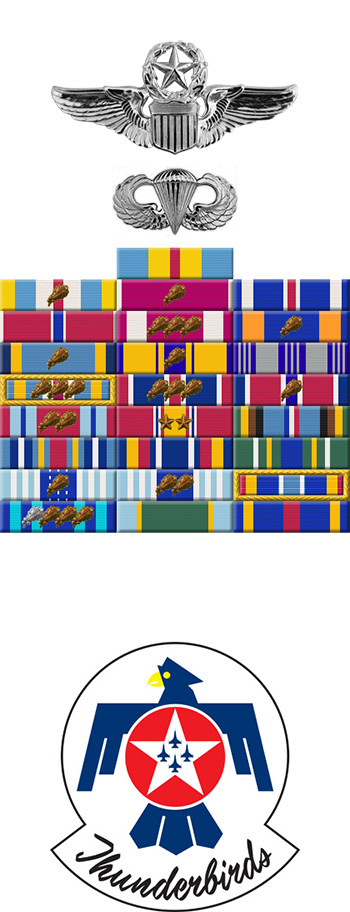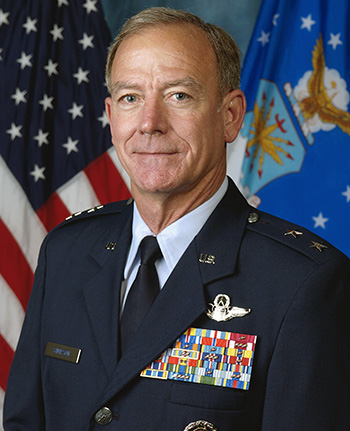
|
Charles N. Simpson |
 |
|||
| Rank, Service | ||||
Major General O-8, U.S. Air Force |
||||
| Veteran of: | ||||
|
||||
| Tribute: | ||||
Charles Simpson was born in 1950 in Temple, Texas. He entered the U.S. Air Force Academy in June 1968, and was commissioned a 2d Lt in the U.S. Air Force on June 7, 1972. While at the Air Force Academy, Cadet Simpson completed the Airborne Parachutist Course at Fort Benning, Georgia, in August 1969. Lt Simpson received an Air Force Institute of Technology assignment to complete his Master's Degree at the University of California at Los Angeles from June 1972 to April 1973, and then attended Undergraduate Pilot Training; earning his pilot wings at Webb AFB, Texas, in June 1974. He next attended F-4 Phantom II upgrade training at Luke AFB, Arizona, from July 1974 to June 1975, followed by service as an F-4 pilot with the 80th Tactical Fighter Squadron (TFS) at Kunsan AB, South Korea, from July 1975 to July 1976. Captain Simpson served as an F-4 Fighter Weapons Instructor Pilot with the 336th TFS at Seymour Johnson AFB, North Carolina, from August 1976 to December 1979, and then as an F-4 and F-16 Fighting Falcon instructor pilot with the 496th and 313th Tactical Fighter Squadrons at Hahn AB, West Germany, from January 1980 to December 1983. Major Simpson next served as Chief of the F-16 Project Office, and then as Assistant Director of Tactics and Test Operations, with the 57th Fighter Weapons Wing at Nellis AFB, Nevada, from January 1984 to July 1986, followed by service as an Operations Officer and then Commander of the F-16 Division with the U.S. Air Force Tactical Fighter Weapons Center at Nellis AFB from July 1986 to October 1989. Colonel Simpson then served as Commander of the U.S. Air Force Air Demonstration Squadron, the Thunderbirds, based at Nellis AFB from November 1989 to January 1992. His next assignment was as Deputy Commander and then Commander of the 31st Operations Group at Homestead AFB, Florida, from February to September 1992, and then as Commander of the 363rd Operations Group at Shaw AFB, South Carolina, from October 1992 to July 1993. He attended the National War College at Fort Lesley J. McNair in Washington, D.C., from August 1993 to June 1994, and then served as a Joint Staff planner with the Operational Plans and Interoperability Directorate, Joint Staff J7, at the Pentagon from June 1994 to January 1995. He then served as Branch Chief with the NATO and European Division and Chief of the Policy Division, Joint Staff J5, at the Pentagon from February 1995 to April 1997. Brigadier General Simpson's next assignment was as a U-2 Dragon Lady pilot and Commander of the 9th Reconnaissance Wing at Beale AFB, California, from April 1997 to June 1999, followed by service as Commander of the 363rd Air Expeditionary Wing at Prince Sultan AB, Saudi Arabia, from June 1999 to July 2000. He served as Director of Plans and Policy with Headquarters U.S. European Command at Stuttgart, Germany, from August 2000 to March 2002, and then as Director of Air and Space Operations with Headquarters U.S. Air Forces in Europe at Ramstein AB, Germany, from March 2002 to July 2004. During this time he deployed to Tel Aviv, Israel, where he served as Commander of the Strategic Liaison Cell and Mobile Air Operations Center in support of Operation Iraqi Freedom from March to April 2003. Major General Simpson's final assignment was as Director of Requirements and Integration with Headquarters U.S. Joint Forces Command at Norfolk, Virginia, from August 2004 until his retirement from the Air Force on January 1, 2007. General Simpson is a Command Pilot with over 4,700 flying hours in the T-37 Tweet, T-38 Talon, F-4 Phantom II, F-16 Fighting Falcon, and U-2 Dragon Lady aircraft, with over 160 combat flying hours in support of Operation Southern Watch. |
||||
|
||||

